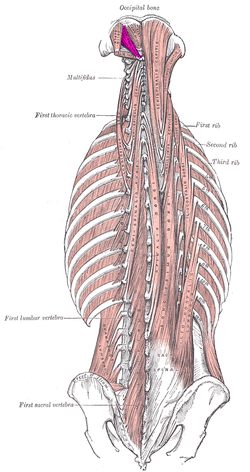The rectus capitis posterior major (or rectus capitis posticus major[citation needed]) is a muscle in the upper back part of the neck. It is one of the suboccipital muscles. Its inferior attachment is at the spinous process of the axis (Second cervical vertebra); its superior attachment is onto the outer surface of the occipital bone on and around the side part of the inferior nuchal line. The muscle is innervated by the suboccipital nerve (the posterior ramus of cervical spinal nerve C1). The muscle acts to extend the head and rotate the head to its side.
| Rectus capitis posterior major muscle | |
|---|---|
 Deep muscles of the back. (Rect. post. major visible at upper left.) | |
| Details | |
| Origin | Spinous process of the axis (C2) |
| Insertion | Inferior nuchal line of the occipital bone |
| Artery | Occipital artery |
| Nerve | Dorsal ramus of C1 (suboccipital nerve), sub-occipital nerve |
| Actions | Ipsilateral rotation of head and extension |
| Identifiers | |
| Latin | musculus rectus capitis posterior major |
| TA98 | A04.2.02.004 |
| TA2 | 2249 |
| FMA | 32525 |
| Anatomical terms of muscle | |
Anatomy
editThe rectus capitis posterior major muscle is one of the suboccipital muscles. It forms the superomedial boundary of the suboccipital triangle.[1]
The muscle extends obliquely[2] superiolaterally from its inferior attachment to its superior attachment.[1][2] It becomes broader superiorly.[1]
Attachments
editIts inferior attachment is (via a pointed tendon[1]) at (the external aspect of) the (bifid)[2] spinous process of the axis (cervical vertebra C2).[1]
Its superior attachment is at (the lateral portion of[1][2]) the inferior nuchal line[1] and the surface of the occipital bone just inferior to this line.[1][2]
Innervation
editThe muscle receives motor innervation from the suboccipital nerve (the posterior ramus of cervical spinal nerve C1).[2][1]
Relations
editSuperiorly, as the two muscles diverge laterally, they create between them a triangular space in which parts of the two recti capitis posteriores minores muscles are exposed.[1]
Actions/movements
editThe muscle extends the head and (acting together with the obliquus capitis inferior muscle[1]) ipsilaterally rotates the head.[1][2]
Function
editIts main actions are to extend and rotate the atlanto-occipital joint.
Research
editA soft tissue connection bridging from the rectus capitis posterior major to the cervical dura mater was described in 2011. Various clinical manifestations may be linked to this anatomical relationship.[3] It has also been postulated that this connection serves as a monitor of dural tension along with the rectus capitis posterior minor and the obliquus capitis inferior.[citation needed]
See also
editAdditional images
edit-
Position of rectus capitis posterior major muscle (shown in red).
-
Rectus capitis posterior major muscle.
-
Occipital bone. Outer surface.
-
Rectus capitis posterior major's relationship to other suboccipital muscles.
References
editThis article incorporates text in the public domain from page 401 of the 20th edition of Gray's Anatomy (1918)
- ^ a b c d e f g h i j k l Standring, Susan (2020). Gray's Anatomy: The Anatomical Basis of Clinical Practice (42th ed.). New York. pp. 848–849. ISBN 978-0-7020-7707-4. OCLC 1201341621.
{{cite book}}: CS1 maint: location missing publisher (link) - ^ a b c d e f g Sinnatamby, Chummy S. (2011). Last's Anatomy (12th ed.). p. 430. ISBN 978-0-7295-3752-0.
- ^ Frank Scali; Eric S. Marsili; Matt E. Pontell (2011). "Anatomical Connection Between the Rectus Capitis Posterior Major and the Dura Mater". Spine. 36 (25): E1612–4. doi:10.1097/BRS.0b013e31821129df. PMID 21278628. S2CID 31560001.
External links
edit- PTCentral
- Anatomy photo:01:10-0102 at the SUNY Downstate Medical Center
- Anatomy figure: 01:07-04 at Human Anatomy Online, SUNY Downstate Medical Center